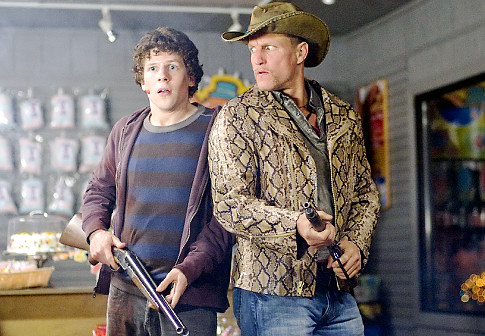
After decades of watching the poor zombies making their listless shuffle from one bite to another, it’s refreshing to see them up and running. In Ruben Fleischer’s Zombieland (2009), the living dead spring at their victims, chase them around; make them appreciate their cardio. That concept, along with outstanding performances by everyone involved (Jesse Eisenberg’s angular awkwardness turns into beauty before our eyes, as always is the case with him) still doesn’t rescue the movie for me. The script is shifty-eyed, pacing is awkward and more than one idea seems superfluous (Bill Murray’s turn makes for a gigantic wink the movie snaps under). Also, the strange indecisiveness as to whether Zombieland cares about its characters’ plight at all undermines many scenes, namely the short flashback giving you insight to Woody Harrelson’s personal tragedy. This shamelessly sentimental pull is bad enough in itself, but then the writers put a crass line on top of it: “I haven’t cried like that since Titanic!”.
Thematically, the movie is a variation on The Grapes of Wrath (1940) – only this time it’s a makeshift family (rather than a biological one) that makes its way through the American wasteland. Also: instead of piousness and perseverance, what dominates here is violence – in case of Harrleson’s character verging on sadistic – and it’s small wonder that the most pronounced tribute is paid to Kubrick and his A Clockwork Orange (1971) when a gleeful, destructive orgy is played out to Mozart’s Le Nozze di Figaro overture.
The journey ends in an amusement park – the only safe place to be, at least for a while – which made me think of the Coney Island finale of The Warriors (1979), but also of the more direct America-as-a-Loony-House inspiration, which Spielberg’s 1941 (1979) probably was. Unfortunately, Fleischer proved unable of pulling the great Spielbergian trick: the amusement park in Zombieland, instead of being a structural matrix for the whole film, remains a mere location.





No comments:
Post a Comment